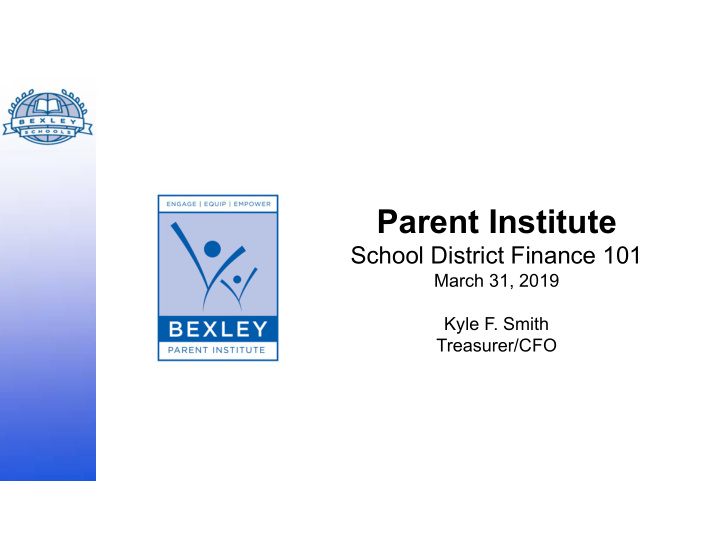



Parent Institute School District Finance 101 March 31, 2019 Kyle F. Smith Treasurer/CFO
… the basics Revenues Expenses Budgets and Forecasts A few statistics worth sharing
The source: Ohio Department of Education
Revenue Sources
Formulas State Revenue Factors DeRolph – adequate and equitable Property values and census based income Enrollment size and district type (rural, urban, small town etc.) State-Share Index Number – unique to each district State budget adjusts every two years (biennium July ’19-June ‘21) Guarantee and Cap Federal Revenue Factors Poverty (Free and Reduced Lunch counts) Special Education enrollment Strings attached on how it can be spent
The “local” portion Property Taxes (all schools) Voted + Unvoted (Inside Mills) Total and Effective • HB920 – Essentially freezes property tax revenue. It is protected from inflation when county auditors reassess values every 6 years. Inside mills is the only exception. Market Value vs. Assessed Value • Taxed on Assessed Value (35% of Market) Taxation unit is a mill; 1/10 of a penny • 1 mill = $35 per $100,000 of market value, annually Timing of district revenue – Jan/Feb and Jul/Aug
The “local” portion continued School District Income Taxes Commonly found in wealthy and farming communities • 31% of school districts have an income tax • Personal tax returns are not public or shared with the district 2 types • Traditional (All income) • Earned Increments of .25% Timing of district revenue – Jan/Apr/Jul/Oct Bexley School District Income Tax? • Traditional & .75%
Operating Expenditure Categories
Expenditures Salaries Union contracts – Salary Schedules Classroom sizes or staffing needs Benefits Union contracts for insurance coverage Retirement, Medicare, Worker’s Compensation Purchased Services Utilities and repairs Professional services for Professional Development and Legal • Bexley – substitute teachers and teacher aides
Other ways to classify expenditures Instruction Instructional delivery to students Building Operations Utilities and Maintenance Pupil Support Counseling, Psychologists and services that enhance the development processes of the students. Staff Support Instructional improvement (Professional Development) Administration Day to day operations of the school building and central office
Where are the expenses directed? Statewide Average Allocation of Bexley Allocation of Expenditures FY18 Source: Ohio Department of Education Expenditures FY18 Source: Ohio Department of Education 6% Administration 6% 13% Administration 13% 5% Building Operations 4% Building Operations Instruction 15% Instruction 19% Pupil Support Pupil Support Staff Support Staff Support 61% 58%
The thing to consider is how enrollment growth impacts expenditure per pupil.
Budgeting Budget Year is July 1 – June 30 Includes many different funds and thousands of budget codes Filing with Franklin County Auditor Audited yearly by the Ohio Auditor of State Budget codes allow us to track expenditures and compare Must have a positive cash balance at the end of the year At Bexley… Zero-Based Budgets – Planning and needs based Per-Pupil Budgets for buildings Entire Budget (all funds) = 47 Million Operating (General Fund) = 41 Million (on target to spend about 39.7 Million)
The Five-Year Forecast The most important financial document for the district Is an educated guess with the information known at the time It is like a financial health checkup Required to file with Ohio Dept. of Education twice per year Engages the district in expenditure and revenue planning Guides the district in decision making for levy planning, negotiations, staffing and long-term contracts Operating funds only (day to day) Most difficult items to predict: Insurance Benefits, State Funding, School District Income Tax, Enrollment, Special Education needs District Roles: Superintendent, Treasurer and Board of Education
Typical 3‐Year Levy Cycle $39,000,000 $38,000,000 $37,000,000 $36,000,000 $35,000,000 $34,000,000 $33,000,000 <<<Levies are Passed >>> $32,000,000 $31,000,000 $30,000,000 $29,000,000 $28,000,000 FY16 FY17 FY18 FY19 FY20 FY21 FY22 FY23 Revenues Expenditures
Thank you! Questions? Kyle.Smith@bexleyschools.org
Recommend
More recommend